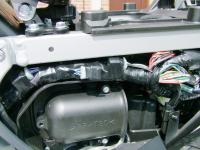My 2015 with under 90,000 miles threw up an Error code number 89, which is a loss of comms between the dash and the ECU. When I went into the Diagnostics the ECU was not there. The bike could run, the dash was powered/illuminated, but there was no speedo or any other data and the rhs screen only showed the fault code. I started by removing the cowling and checking every connector in there, they were all clean and shiny. I then went under the tank and started checking the connectors above and forward of the engine, and found a lot of corroded and dirty connectors. I previously had a nightmare with the spiders on my 2008, ending up with a new loom, and I didn't like the look of these either, see photos.
They've obviously not been electrically stressed or burnt as a Gen 2 would be, but still not good. I cleaned all of the connectors in that area and the fault code went away, all is now good again.
I had a look to see why the connectors in that area were corroded and rough looking. I do commute and my bikes do sit outside all day. Looking at the front of the bike there is an obvious gap above the radiator where wind and rain could get in there. I checked my 2008 and its the same, so could someone tell me:


They've obviously not been electrically stressed or burnt as a Gen 2 would be, but still not good. I cleaned all of the connectors in that area and the fault code went away, all is now good again.
I had a look to see why the connectors in that area were corroded and rough looking. I do commute and my bikes do sit outside all day. Looking at the front of the bike there is an obvious gap above the radiator where wind and rain could get in there. I checked my 2008 and its the same, so could someone tell me:
- Is there something missing on my bikes, like a cover or flap to block that gap? Or
- If I fit a rubber flap will it have an adverse effect, have Yamaha deliberately left the gap open?






